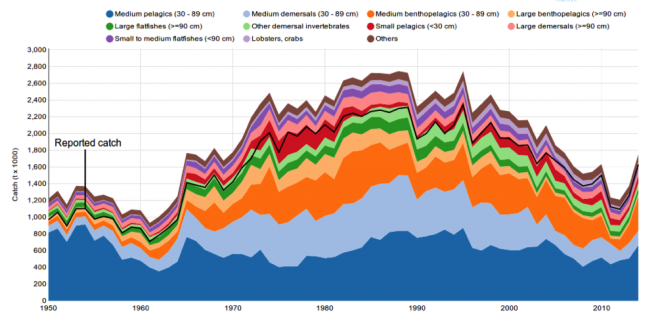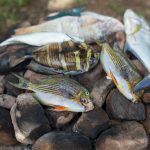Madingley is a General Ecosystem Model and hopes to indirectly represent all forms of life, terrestrial and marine. Nereus Fellow Phil Underwood works with the Madingley model to validate its use as a policy tool in relation to fisheries, ecosystem health, and food security. He is working to better understand the relationship between oceanic ecosystems and human societies. Underwood is improving the ecological realism of the Madingley model in order to generate future projections of fisheries in a global context. Here he gives an update on his research and his efforts to integrate the catch data from the Sea Around Us project into the model.
By Phil Underwood, Nereus Program Fellow at Cambridge/WCMC
A major component of my project is to integrate the Sea Around Us Project catch data in to Madingley; the model I am working with. To meet the processing requirements of the project, work first began on re-implementing the model in a different programming language in order that it could be run on the University of Cambridge’s “Darwin” High Performance Computing Cluster. This work was very technical and time-consuming, but it is finally complete. In recent weeks, the focus of the project has shifted more towards developments that will hopefully lead to outputs of scientific interest. Here’s an update on the current status of this work.
Amongst other things, the catch data contains a reconstructed weight of each fish species removed from the ocean at any given point in space and time, at a 0.5 degree, 1 year resolution. For the waters surrounding the UK, these data look like this:

Figure 1: A summary of catch reconstruction by species for the UK waters, 1950 to 2014.
However, for the particular type of analysis you wish to carry out, they might not be useful in this form. Information is hierarchical. For example, the Atlantic cod (Gadus morhua) is comprised from several stocks spanning the North Atlantic, North Sea, Baltic Sea, and Arctic Sea. Different stocks can experience different conditions in their particular locations, such as differences in temperature, salinity, or food availability. Though they may be regarded as the same species, two comparable fish from spatially distinct stocks may be noticably different from each other. In this way, it can be seen that the data shown in figure 1 above is an aggregation of catch from all the stocks of each species. From this it can be seen that the data can be aggregated even further.
One of the challenges of modelling is balancing computational expense with real-world detail. Models often contain only enough detail for their purpose, and no more. Model features that require more processor time or memory, but which have no bearing on outputs represent at best, wasted effort, and at worst, a misuse of resources. One of the ways ecosystem modellers approach this challenge is to aggregate species in to broad categories that describe a select number of their properties, rather than everything about them. The Madingley model also uses a functional group representation. However, there are considerable differences between the aggregations in the model compared with those in the data. In Madingley, the functional groups are defined by traits such as size, whether they’re a herbivore, omnivore or canivore, warm or cold blooded, and their reproductive strategy (producing single or multiple offspring before dying). In the catch data, functional groups are also defined by size, but this is where the functional group similarities end.
In the data, fish are also defined by where they live in the water column. Pelagic fish live and feed neither close to the coast or sea floor. Bathypelagic fish are a special case. They too are pelagic. However, they carry special adaptations to live in very deep (below 4000m) parts of the ocean. Here, there is extreme darkness and pressure. The only way to survive is to hang motionless in the water column and wait for food to rain down from above. Demersal fish live and feed whilst on or near the sea floor. Bathydemersals are dermersal fish that live at depths greater than 200m. Benthopelagic fish live just above the sea floor, feeding on benthic organisms and zooplankton. The data contains small (<30cm), medium (30-90cm), and large (>90cm) categories for each. In addition, there are specific size-based aggregations for sharks, rays and flatfishes, and categories for reef associated fish, cephalopods, shrimps, lobsters and crabs, jellyfish, and krill. With these, the catch data look like this:

Figure 2: A summary of catch reconstruction by functional group for the UK waters, 1950 to 2014.
It’s understood that the categories defined by the Sea Around Us project group reperesent a minimal number of species aggregations. Combining the more specific groups into a general size and depth functional group would likely produce confusing relationships where groups feed on themselves. The more specific functional groups permit a better representation of the predator-prey relationships. Madingley does not currently place much emphasis on ecological realism. Because of a simple size-based predatory mechanism, it’s quite possible that a model individual could feed on one of its own kind.
Due to the grounded principles on which the functional groups in the data are based, it has been decided that these will be imported into the model. The simplest case will be to instantiate the functional groups and simply allow them to move and eat under the existing rules defined by the model. This will make the model compatible with the catch data, but it’s likely that the absence of marine habitats and ecological rules will introduce inconsistencies, such as deep-ocean dwelling animals thriving on the coast, and vice-versa. It’s possible that the model may be unable to fulfill the catch at certain points in space and time (these eventualities will be logged). Findings such as this will introduce a phase of work to improve the predator-prey relationships and habitat representation in the model to better reflect the ecosystem dynamics it hopes to capture.
Another thing to consider is the fact that the catch data is focussed on marine species that are commercially exploited. Madingley is a General Ecosystem Model and hopes to indirectly represent all forms of life, terrestrial and marine. Although commercial fishing practices can be considered indiscriminatory and somewhat devastating to the marine systems, it would be unrealistic to assume that all animals in the ocean are commercially exploited. It’s been suggested that a way to approach this is to duplicate the small functional groups so that some are commercially exploited, and some are not.
This work is ongoing. It’s currently unclear how the model will respond when catch will be applied, or what work will need to be done to improve the outputs. However, it is expected that preliminary outputs will be presented at this year’s Nereus Annual General Meeting at Princeton University, USA in June, and at the Advances in Marine Ecosystem Modelling Research conference at Plymouth University, UK in July. With the feedback and information from these meetings, it is hoped that Madingley will feature in the line-up of models contributing to the Fish Model Intercomparison Project (FishMIP).
The author would like to thank his supervisors, colleagues and friends for their time, efforts and helpful discussions which have guided and supported this work, particularly during his recent visit to UBC.
 PHIL UNDERWOOD, PHD, THEORETICAL ECOLOGY
PHIL UNDERWOOD, PHD, THEORETICAL ECOLOGY
Cambridge/WCMC
Phil Underwood works with the Madingley model to validate its use as a policy informing tool in relation to fisheries and food security. As a member of the Nereus Program, Underwood will be working to better understand the relationship between oceanic ecosystems and human societies. To this end he will improve the ecological realism of the Madingley Model in order to generate future projections of fisheries in a global context.







